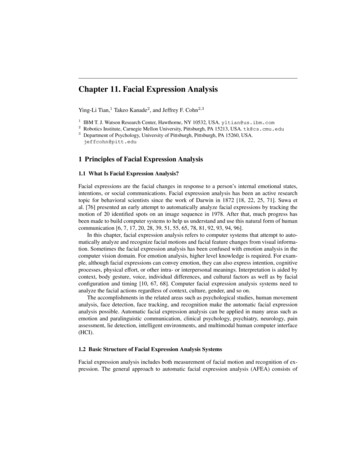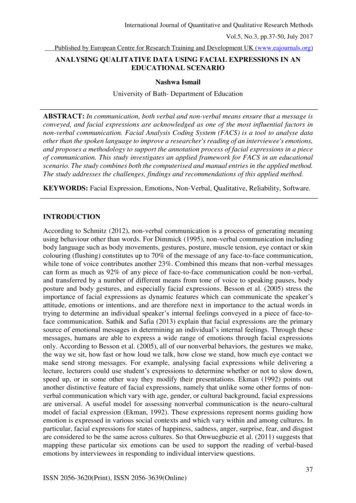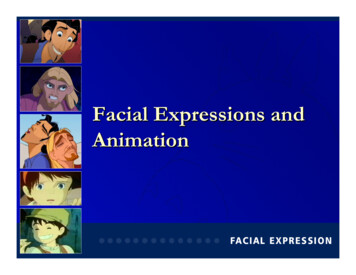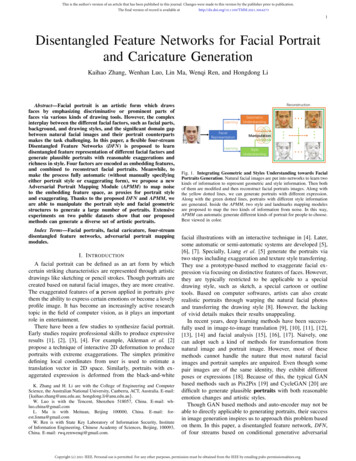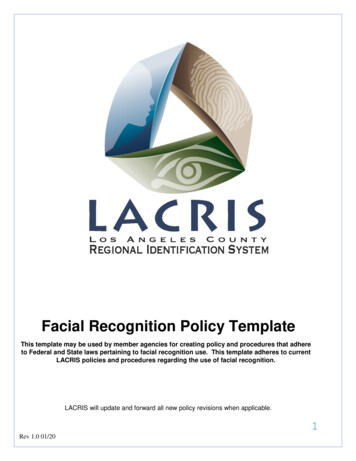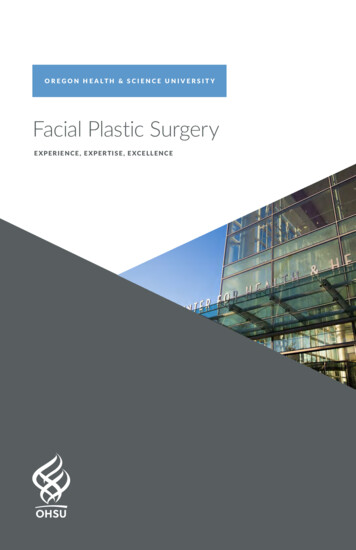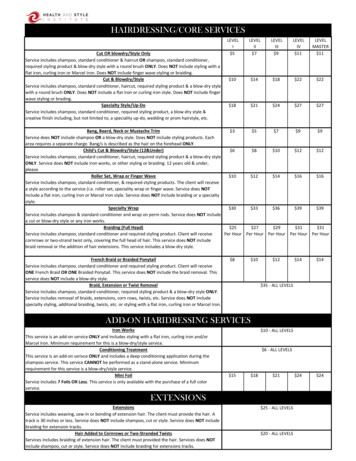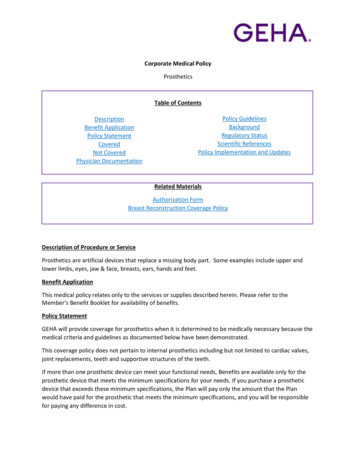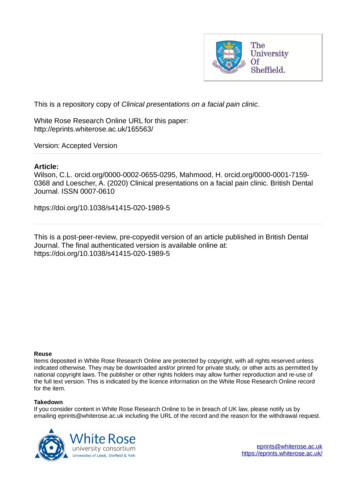
Transcription
This is a repository copy of Clinical presentations on a facial pain clinic.White Rose Research Online URL for this n: Accepted VersionArticle:Wilson, C.L. orcid.org/0000-0002-0655-0295, Mahmood, H. orcid.org/0000-0001-71590368 and Loescher, A. (2020) Clinical presentations on a facial pain clinic. British DentalJournal. ISSN This is a post-peer-review, pre-copyedit version of an article published in British DentalJournal. The final authenticated version is available online tems deposited in White Rose Research Online are protected by copyright, with all rights reserved unlessindicated otherwise. They may be downloaded and/or printed for private study, or other acts as permitted bynational copyright laws. The publisher or other rights holders may allow further reproduction and re-use ofthe full text version. This is indicated by the licence information on the White Rose Research Online recordfor the item.TakedownIf you consider content in White Rose Research Online to be in breach of UK law, please notify us byemailing eprints@whiterose.ac.uk including the URL of the record and the reason for the withdrawal terose.ac.uk/
AbstractIntroductionThe complex nature of facial pain conditions creates a diagnostic challenge and oftennecessitates specialist referral.AimTo identify the case mix presenting to a specialist tertiary care facial pain clinic.MethodsA retrospective review of 112 patient records was undertaken. Trends in provisionaldiagnoses from referrers and the correlation to diagnoses made following specialistconsultation were reviewed.ResultsThe most common provisional diagnoses recorded in referral letters were painfultemporomandibular disorders, trigeminal neuralgia and persistent idiopathic facial pain. Overa quarter of referrals did not include a provisional diagnosis. Following assessment, only onecase was not given a definitive diagnosis and no patients were diagnosed with persistentidiopathic facial pain (PIFP). A causative factor was identified in all the initially queried PIFPcases, and post-traumatic trigeminal neuropathic pain was found in multiple patients.ConclusionsPost-traumatic trigeminal neuropathic pain should be considered if pain onset coincides withdental treatment or other traumatic events. PIFP is a rare facial pain diagnosis and may beover-diagnosed by dental and medical practitioners. It is important to systematically excludeother causes before reaching this diagnosis. This will facilitate effective treatment, managepatient expectations and potentially reduce unnecessary referrals.
IntroductionFacial pain is complex and diagnosis is difficult1,2. Achieving optimal management isdependent on each patient having the correct diagnosis of their facial pain to inform decisionsabout appropriate treatment modalities.The impact of these conditions on patients should not be underestimated; frequentlyaffecting their daily life. Patients have reported that persistent orofacial pain can havesignificant effects on their psychological health, work performance and ability to participatein social activities3. Studies have also shown that there is a financial impact of persistentorofacial pain to both the patient and the heath service, particularly among those with highGraded Chronic Pain scores4,5. This may be linked to the increased number of consultations,with these patients attending multiple appointments across different specialties to obtain adiagnosis and find the root cause of their pain3,4.MethodsA retrospective cross-sectional analysis was carried out by two clinicians using case notes forpatients attending a specialist facial pain clinic between January 2017 and May 2018 at theCharles Clifford Dental Hospital, Sheffield, UK. This clinic only accepts referrals for patientsfrom 16 years and older and is led by a Consultant Oral Surgeon. Of the 210 new patients seenwithin this time frame, 120 cases were selected from the clinic list using convenience samplingbased on clinical record availability. Data collected included patient demographics (age,gender and medical history), referrer details (specialist, general medical practitioner (GMP)or dental practitioner (GDP)), the referrer’s provisional diagnosis and definitive diagnosisfollowing assessment on the specialist clinic. Patients seen with an absence of facial painsymptoms were excluded from the review.The principle aims of this review were to identify trends in conditions treated on a specialistfacial pain clinic and to assess the correlation between referrer provisional diagnosis anddefinitive diagnosis following specialist consultation.
ResultsDemographics8 patients were excluded due to inappropriate booking on the facial pain clinic (i.e. patientsnot presenting with facial pain), resulting in 112 patients included in this study. 90 (80%)patients were female, which aligns with the known demographics of patients who experiencefacial pain6. Age of patients at assessment ranged from 16 to 98 years old, with a peakbetween 41-70 years and in under 21 years old (Figure 1). The majority of younger patients(26 of the 27 patients under 41 years old) were those diagnosed with painfultemporomandibular disorders (TMD).Most referrals came from general dental practitioners (Figure 2), but almost a third were fromother dental and medical specialties including Oral and Maxillofacial Surgery, Neurology andEar, Nose and Throat. The duration of pain symptoms for most patients varied between a fewmonths to years (mode one year; median three years). However, for some this was as muchas 20 years (Figure 3), indicating that their diagnosis may have not been clarified and/or theirtreatment not satisfactorily optimised for a significant length of time.Although most patients did not report medical comorbidities, chronic pain conditions such asfibromyalgia, chronic back pain and irritable bowel syndrome were found in 14% of patients.All but one of these patients was subsequently given a diagnosis of TMD.DiagnosesThe most common provisional diagnoses recorded in referral letters were TMD (31% ofreferrals), neuropathic pain conditions (19%) and persistent idiopathic facial pain (PIFP) (17%)(Figure 4). Of the neuropathic pain category, the most common provisional diagnosis (13% ofall referrals) was trigeminal neuralgia (TN) (Figure 5). 43% of these TN diagnoses wereconfirmed as the classical subtype due to vascular conflict with the trigeminal nerve onMagnetic Resonance Imaging (MRI).Six referrals provided multiple provisional diagnoses, however over a quarter (26%) ofreferrals did not include any provisional orofacial pain diagnosis (Figure 4). This could indicatethat referrers may feel unsure of the diagnosis and/or unconfident in making a diagnosis and
highlights the challenge of diagnosing facial pain conditions. 12 patients were diagnosed inthe department as having multiple diagnoses contributing to their facial pain.Provisional or differential diagnoses proposed by the referrer matched the diagnosis made inthe specialist clinic in 43% of cases (48/112). Of the 35 patients referred with a provisionaldiagnosis of TMD, 34 were confirmed to have a diagnosis of TMD on the specialist clinic.The most common definitive diagnoses were TMD which was found in 74% of patients,followed by neuropathic pain conditions which were identified in almost a quarter (24%) ofpatients seen (Figure 4). 84% of patients diagnosed with TMD were female.A dental cause for pain was identified in 9% of cases which was over double the numberreferred with this as the provisional diagnosis (Figure 4). In the case of the patients diagnosedwith dental pain, the duration they had been experiencing pain ranged from one month to 10years. Half of the patients with dental pain also had TMD. Interestingly, all 10 patients whowere diagnosed with a dental cause of pain on the specialist clinic were referred from GDPs,of which only two considered dental pain as their provisional diagnosis.All 19 cases where the referrer had provisionally diagnosed PIFP, or used the formerdescriptor of “atypical facial pain”, were given an alternative facial pain diagnosis followingspecialist consultation, with the majority found to have TMD. No patients were given a finaldiagnosis of PIFP, but one case did not have a definitive diagnosis following assessment onthe clinic (Figure 4). One patient was diagnosed with myositis and painful dry eyes (“other”category, Figure 4). This was included in this study as this caused facial pain, however theywere referred to dermatology as a more appropriate management centre for this condition.TN was the most commonly diagnosed neuropathic pain (Figure 5). Three cases were foundto have idiopathic painful trigeminal neuropathy and eight cases were identified to havepainful post-traumatic trigeminal neuropathy (PPTTN) following specialist assessment (Figure5). However, no patients were referred with either of these as a provisional diagnosis.Few patients were referred or diagnosed with primary headache conditions or burning mouthsyndrome (BMS) (Figures 4, 5). This had been anticipated as there are other more appropriatereferral pathways for these conditions (such as Neurology, Ear Nose & Throat and OralMedicine) within this hospital trust.
DiscussionTMD was the most frequent diagnosisThese results concur with the literature that TMD is a common facial pain diagnosis oftenaffecting female and younger patients than other types of facial pain7. However, thefrequency of TMD as a diagnosis on this clinic was a surprising finding as the dental hospitalalso has specific TMD tertiary referral clinics.TMD represents a group of disorders where the temporomandibular joint itself and/or thesurrounding musculature are the sources of the facial pain8. Common presentations includehypertrophy and tenderness of the muscles of mastication, clicking, locking and/or crepituswithin the temporomandibular joint9, 10 and the classification of TMD conditions reflects this(Table 1). Nevertheless, other presentations may include headaches, perceived alteredsensation and/or dental pain7,9,10,11. It was noted that 4 cases had headache symptoms butwere identified as having TMD, which are likely to represent ‘headache attributed to TMD’subclassifications of TMD (Table 1). However, the retrospective nature of this study relied oncomprehensive record keeping and in the case of TMD it was not always clearly documentedas to the exact subclassification, so further analysis of this was not possible.It should be noted that this condition may present concomitantly or secondary to otherlongstanding facial pain conditions7. In this study, TMD was by far the most common facialpain diagnosis in patients with other chronic pain conditions. Previous studies havehighlighted that chronic facial pain conditions may be comorbid with other bodily chronic painincluding fibromyalgia, neck pain, back pain and irritable bowel syndrome12-15. Comorbidityof chronic widespread pain conditions has been demonstrated in TMD specifically14,16,17 andthe presence of such conditions is a risk factor in the development of chronic TMD18. Chronicwidespread pain has also been found to be negatively associated with treatment outcomesfrom splint therapy19. Practitioners should be mindful of the more refractory nature of TMDin patients with widespread pain and ensure appropriate management is implementedearly20.
The high numbers of TMD diagnoses highlights the importance of referrers considering thisand being aware of the varying presentations of TMD conditions. Many patients werecorrectly referred with a provisional diagnosis of TMD suggesting that there was awarenessof this condition among referrers. However, in this study TMD represented 31% of provisionaldiagnoses by referrers, but 74% of definitive diagnoses made on the specialist clinicsuggesting that many TMDs seen were not being identified early. This may be because of thevariable and complex nature of TMD presentation that can confuse diagnosis and account forthe lower proportion of TMD cases identified by referrers compared to the specialist clinic.This highlights the importance of a comprehensive examination of the temporomandibularjoint and muscles of mastication to exclude this as a possible diagnosis, prior to referral to thespecialist pain clinic. Further education for referring practitioners may help them improvetheir diagnostic decision-making skills10.It should also be noted that this review looked at the primary diagnoses following initialassessment on the facial pain clinic. Given that TMD can be comorbid with other facial paindisorders, it may be that a proportion of these patients also had subsequent diagnoses thatwere further investigated and identified after treatment of their TMD. This may alsocontribute to the high proportion of primary definitive diagnoses of TMD.Dental pain was the fourth most common diagnosis made on the clinicDental pain is a very common complaint, affecting 9% of dentate adults in the UK21.Nonetheless, these results demonstrate how this diagnosis can sometimes be hard to reach,even among the dental profession, and could be complicated by coexisting pain conditions.Four patients in this cohort were found to have both dental pain and TMD secondary tobruxism. One patient was found to have TMD following a dental procedure. This highlightsthe role of a thorough history, as well as clinical assessment including the facial musculature,is necessary. Signs and symptoms of tongue scalloping, linea alba and generalised bilateraldental pain and/or burning tongue may all indicate a potential bruxism parafunctionalhabit22,23.
PIFP was not seen in this cohort of facial pain patientsAll patients referred with PIFP were found to have other causes of their pain followingacquisition of a detailed history and clinical assessment on the specialist clinic. Previous studyof the prevalence of PIFP in Germany also found it to be a very rare condition (0.03% lifetimeprevalence) and far less common than TN24. PIFP has been shown to present a particulardiagnostic challenge for dentists25. The diagnosis of PIFP is reached by exclusion of all otherknown causes of facial pain6,26 (Table 2).Limited consultation time for many primary care practitioners may present a barrier todiagnosis of facial pain conditions, as thorough history-taking and examination assessment isrequired to facilitate accurate diagnosis1,2,27. Moreover, chronic facial pain conditions mayhave a large psychological component1 and can cause hypervigilance in some patients. Thiscould create confusion for the practitioner in making a confident definitive diagnosis,particularly if the patient presents a complex pain history. Over-diagnosis of PIFP may also berelated to practitioner knowledge of facial pain diagnoses and the updated classification ofthese conditions.There is potential for this cohort of patients to either not be treated appropriately or be overinvestigated given the challenge with reaching a diagnosis of PIFP28, particularly given theabsence of a known cause for this condition.It should be noted that one patient was not diagnosed following assessment on the clinic andcould be considered to fall into the diagnostic category of PIFP. However, from discussionwith this patient, the specialist clinician did not feel that attaching the label of PIFP would behelpful in this case. Use of the diagnosis of PIFP should be with caution as this label may riskpractitioners overlooking other, potentially treatable, causes of chronic pain. Moreover, forthe patients involved this may result in them not receiving a clear explanation of causation oftheir pain if another cause has been overlooked, adding to the psychological burden ofchronic facial pain.Trigeminal Neuralgia was the most common neuropathic pain diagnosis
Similar to TMD, the diagnostic accuracy of the referrers with TN was generally good, with nineof the 14 referrals correctly offering this diagnosis. This may be because TN usually has verydistinct features of unilateral severe electric-shock pain that lasts less than two minutes andis abrupt in onset and termination and is confined within the area innervated by one or moredivisions of the trigeminal nerve6. However, whilst many patients have characteristicpresentations, sometimes there are other features that may confuse the clinician such as apersistent background facial pain (defined in ICHD-3 as concomitant continuous pain6,20. Thismay account for the 5 TN patients provisionally diagnosed with either unknown pain or PIFP.TN is a clinical diagnosis which can be subclassified based on MRI findings as classical(evidence of vascular conflict at the dorsal root entry zone of the trigeminal nerve), secondary(due to space occupying lesions or central demyelinating conditions such as multiple sclerosis)or idiopathic (exclusion of a vascular or secondary cause)20. Subclassification may assist withsurgical treatment planning for patients where medical treatment is suboptimal. For example,microvascular decompression is the most successful surgical treatment option, but this is onlyeffective for the classical TN subgroup20.Painful post-traumatic trigeminal neuropathy and idiopathic painful trigeminal neuropathywere not identified by referrersInterestingly three patients were found to have idiopathic painful trigeminal neuropathy.Unlike TN, this is not associated with triggers and is a constant sensory deficit within thedistribution of the trigeminal nerve indicating it has been damaged6. Unlike PIFP, in thiscondition there is clinical evidence of dysfunction in the nerve, which may include burning(dysaesthesia), reduced sensation (hypoesthesia), and/or tingling sensation (paraesthesia)(Table 2). It is therefore similar to PPTTN, although without the history of a traumatic event.These key differences in the history and examination findings help distinguish these similarconditions.PPTTN was not included in any provisional diagnoses but represented 7% of definitivediagnoses. PPTTN is a condition of trigeminal dysfunction within months of a traumatic event.It occurs secondary to neural trauma in the facial region (Table 2)6,29. The term “trauma” can
relate to events such as tooth extraction, root canal treatment, dental abscesses, avulsion orradiotherapy6,29. Whilst most patients will recover uneventfully from such experiences, somepatients continue to experience pain, even in the presence of clinically normal tissuehealing29. Previous studies have suggested the prevalence may be as high as 3% of cases oftrigeminal nerve injury30 – a particularly alarming statistic given the number of dentalprocedures patients undergo. In these cases, patients can identify the onset of their paincorrelating to the traumatic event6,29,30. However, it has been acknowledged that the signs ofPPTTN may be subtle and may overlap with symptoms of other neuralgias or odontogenicpain28.The International Classification of Headache Disorders (ICHD-3) classify PIFP and PPTTN incompletely separate categories (Table 2)6, as does the recently published InternationalClassification of Orofacial Pain (ICOP-1)31. One key difference in the ICOP-1 is that atypicalodontalgia has been reclassified from a subgroup of PIFP to a separate category of persistentidiopathic dentoalveolar pain31. However it is acknowledged that atypical odontalgiasymptoms, whilst generally categorised alongside PIFP, may be alternatively considered asubgroup of PPTTN when there is a history of trauma6. This similarity between theseconditions highlights the need to establish a clear timeline of events during a chronic facialpain history to ensure that PPTTN is ruled out before concluding it is idiopathic. Patients mayor may not have associated a traumatic cause to the onset of their pain. To elicit this level ofdetail from the pain history requires a systematic and thorough approach. In this study, weidentified three cases that were provisionally diagnosed with PIFP but were found to havePPTTN following the specialist clinic assessment.With persistent idiopathic trigeminal neuropathy, PPTTN and PIFP conditions, managementis challenging, and recommended medicinal treatments are similar. Some practitioners mayfeel that such semantics will not affect the medical management of the pain, and thereforemay not perceive a benefit in acknowledging the traumatic history in PPTTN over PIFP orpersistent idiopathic trigeminal neuropathy. However, this classification may assist withinforming patients and developing their understanding of their pain. In the sociologicalliterature, it has been demonstrated that conditions with a perceived physical origin (forexample within facial pain this may be a diagnosis of trigeminal neuralgia due to vascularcompression of the trigeminal nerve) are considered to be less controllable and elicit a more
sympathetic and supportive response from others than those of mental-behavioural origin32.With the diagnosis of PIFP, the diagnostic features being a lack of identifiable cause wouldplace this in the category of chronic pain conditions of medically unexplained symptoms.Patients may struggle with this diagnosis as they may be perceived as being psychologicallycreated by the patient and feel stigmatised33. Such labelling may attribute a level of blameand thus inhibit patient acceptance of pain. Pain acceptance is a well-recognised attribute toadjustment and functional improvement34. It is important that clinicians remove any sense ofblame to empower patients to construct an illness narrative to aid their understanding andacceptance of pain35.In contrast, the cause and effect relationship of trauma with PPTTN is simple and logical tothose who have experienced the pain. This may help to reassure patients and increase theirability to reach an acceptance with their pain. Giving patients a tangible mechanism ofcausation has been identified to improve their psychological assimilation of medicallyunexplained symptoms35. However further research into patients’ perception of theirdiagnosis in the field of chronic facial pain is needed.LimitationsThe sample size was restricted due to the significant demands that service evaluation projectsplace on the clinical records team. Whilst a reasonable sample size was obtained, a largersample of patients seen within a year may be more representative and increase reliability ofthe results. Including all patients seen, rather than using convenience sampling, may avoidany unintended selection bias. This area would therefore benefit from a more in depth,prospective study.Furthermore, the retrospective nature of the data collection limited the depth of data capturein the study. For example, subclassifications of TMD were not analysed as there was variablerecording of the category of TMD. Further work prospectively could utilise proformas toensure that category of TMD (Table 1) is clearly recorded for every case where TMD isdiagnosed. This could help identify whether there are trends in the type of TMD when this iscomorbid with other conditions, such as dental pain.
Using a retrospective data collection technique also meant that no data was collected on thebiopsychosocial aspects of the conditions seen. This data is not routinely collected on theseclinics so was not available as part of this retrospective review. Previous research hasidentified the negative impact of facial pain on patients’ quality of life36, and existing validatedquestionnaires such as those used in the DC/TMD Axis-II37,38 could shed further light on thepatient experience in a future prospective assessment of this clinic.This data only represents the experience of one centre in the UK. The varied referral pathwaysused in different tertiary hospitals may limit the generalisability of these findings.As the review did not question referring practitioners, understanding of their provisionaldiagnosis and their knowledge of facial pain diagnoses was limited by the informationincluded in the referral letters. No referrals mentioned PPTTN or idiopathic painful trigeminalneuropathy, but it is unclear whether this was because practitioners had actively excludedthem or been unaware or unconfident of these diagnoses.Moreover, as this review did not involve direct questioning of patients, or further analysis ofpatient records, it was not possible to ascertain whether any discussion or treatment hadbeen provided successfully in primary or secondary care prior to referral. Further research isrecommended to assess patients’ perception of the impact of having a formal diagnosis andwhether they found diagnosis of a causative factor (such as in TMD or PPTTN) was morehelpful and more accepted than PIFP.ConclusionsTo our knowledge, this is the first review to specifically highlight the varied nature of facialpain presentations seen within a UK specialist facial pain clinic. It is clear from these findingsthat specialist facial pain clinics are an important referral service to support patients withdiverse and complicated facial pain presentations. This review also highlights the need forfurther prospective research into the patients attending specialist facial pain clinics to enableconcurrent evaluation and comparison of the biopsychosocial aspects of the conditions seen.
TMD is a common presentation and should be considered by practitioners within theirdifferential diagnosis when assessing a patient with facial pain. Dental and medicalpractitioners should be aware of first-line management techniques for TMD; includingeducational advice, exercises and splint therapy8. These conservative treatments can beprovided within a primary care setting and prevent unnecessary delays in pain managementfor patients. Clinicians should also consider the potential for concomitant pain disorders thatmay result in confusing pain histories.In contrast, these results suggest possible over-diagnosis of PIFP, and that this may be a rarerfacial pain diagnosis. Sometimes, despite investigating at great length, we are unable todiagnose facial pain, and may term this atypical or idiopathic facial pain. However,practitioners should be aware of the importance of identifying precipitating factors, such asdental treatment, that coincided with the pain development as this can help with PPTTNidentification. PPTTN was an alternative diagnosis identified in several cases by the specialistclinic and it is important to exclude other causes before reaching a diagnosis of PIFP. This willfacilitate more rapid delivery of effective treatment, manage patient expectations andpotentially reduce unnecessary referrals.Declaration of interestsThe authors declared no potential conflicts of interest with respect to the research, funding,authorship, and/or publication of this article.In brief Highlights the importance of excluding other causes before diagnosing persistentidiopathic facial pain Demonstrates the under-diagnosis of temporomandibular joint dysfunction amongreferrals Highlights the potential for dental surgery interventions to result in painful posttraumatic trigeminal neuralgia
References1.Davies A, Barker C. First Consultation, Follow-up and Discharge. In Core Standards forPain Management Services in the UK. pp 94-96. London, UK: The Faculty of Pain Medicine ofthe Royal College of Anaesthetists, 2015.2.Egbuniwe O, Renton T. Pain paper 2b: classification of orofacial pain and an update onassessment and diagnosis. Dent Update 2015; 42: 336-345.3.Breckons M, Bissett SM, Exley C, Araujo-Soares V, Durham J. Care Pathways inPersistent Orofacial Pain: Qualitative Evidence from the DEEP Study. JDR Clin Trans Res 2017;2: 48-57.4.Durham J, Shen J, Breckons M, et al. Healthcare Cost and Impact of Persistent OrofacialPain: The DEEP Study Cohort. J Dent Res 2016; 95: 1147-1154.5.Breckons M, Shen J, Bunga J, Vale L, Durham J. DEEP Study: Indirect and Out-of-pocketCosts of Persistent Orofacial Pain. J Dent Res 2018; 97: 1200-1206.6.The International Classification of Headache Disorders, 3rd edition (beta version).Cephalalgia 2013; 33: 629-808.7.List T, Jensen RH. Temporomandibular disorders: Old ideas and new concepts.Cephalalgia 2017; 37: 692-704.8.Ghurye S, McMillan R. Orofacial pain - an update on diagnosis and management. BrDent J 2017; 223: 639-647.9.Durham J. Oral surgery: part 3. Temporomandibular disorders. Br Dent J 2013; 215:331-337.10.Virdee J. The headache of temporomandibular disorders. Br Dent J 2018; 224: 132-135.11.Speciali JG, Dach F. Temporomandibular Dysfunction and Headache Disorder.Headache 2015; 55: 72-83.12.Maixner W, Fillingim RB, Williams DA, Smith SB, Slade GD. Overlapping chronic painconditions: implications for diagnosis and classification. J Pain 2016; 17: T93-T107.13.Aggarwal VR, McBeth J, Zakrzewska JM, Lunt M, Macfarlane GJ. The epidemiology ofchronic syndromes that are frequently unexplained: do they have common associatedfactors? Int J Epidemiol 2006; 35: 468-476.
14.Slade GD, Rosen JD, Ohrbach R, et al. Anatomical selectivity in overlap of chronic facialand bodily pain. Pain Rep. 2019; 4: e729.15.Macfarlane TV, Beasley M, Macfarlane GJ. Self-Reported Facial Pain in UK BiobankStudy: Prevalence and Associated Factors. J Oral Maxillofac Res 2014; 5: e2.16.Slade GD, Fillingim RB, Sanders AE, et al. Summary of findings from the OPPERAprospective cohort study of incidence of first-onset temporomandibular disorder:implications and future directions. J Pain 2013; 14: T116-T124.17.Lim PF, Smith S, Bhalang K, Slade GD, Maixner W. Development of temporomandibulardisorders is associated with greater bodily pain experience. Clin J Pain. 2010; 26: 116-120.18.Durham J, Newton-John TR, Zakrzewska JM. Temporomandibular disorders. Br Med J2015; 350: h1154.19.Raphael KG, Marbach JJ
The complex nature of facial pain conditions creates a diagnostic challenge and often necessitates specialist referral . Aim To identify the case mix presenting to a specialist tertiary care facial pain clinic. Methods A retrospective review of 112 patient records was undertaken. Trends in provisional
